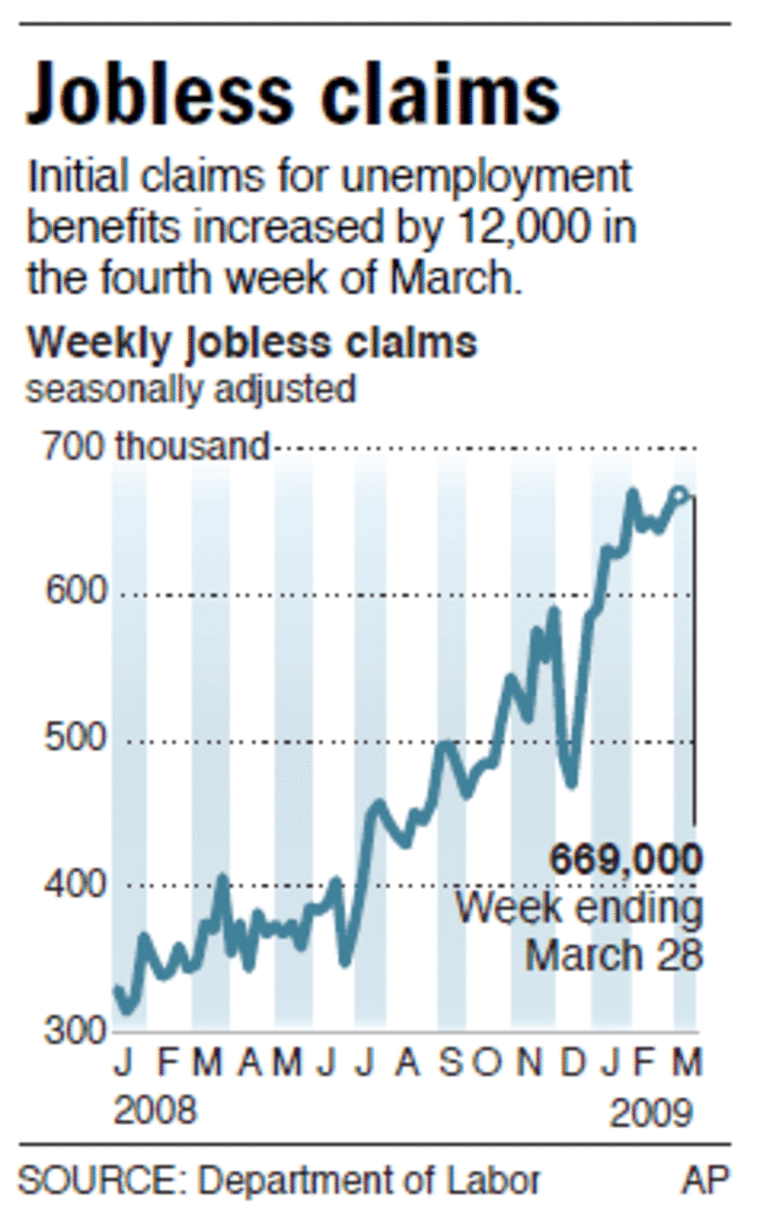Spring may have only just begun, but the economy seems to be pushing up some green shoots that may be faintly signaling the recession has bottomed out.
The Commerce Department said orders for manufactured goods rose 1.8 percent in February, reversing six straight monthly declines and easily beating estimates of another drop. Other economic indicators came in better than expected Wednesday, including construction spending and pending home sales.
Meanwhile, world leaders meeting in London on Thursday pledged $1.1 trillion to global institutions such as the International Monetary Fund to combat the downturn. And the European Central Bank agreed to cut a key interest rate to a record low of 1.25 percent.
Still, the job situation remains grim. Traditionally, the labor market doesn't pick up until well after a recovery has started.
The monthly unemployment report due out Friday likely will be dismal, and new jobless claims reported Thursday were worse than expected.
The Labor Department said initial claims for unemployment insurance rose to a seasonally adjusted 669,000 from the previous week's revised figure of 657,000. That total was above analysts' expectations and the highest in more than 26 years, though the work force has grown by about half since then.
Economists said the jobless claims figures indicate that companies continue to lay off workers at a rapid pace.
"Claims are typically one of the very first indicators to signal economic recovery, and there is no sign of that in the data yet," Ian Shepherdson, chief U.S. economist at High Frequency Economics, wrote in a client note.
The tally of laid-off workers claiming benefits for more than a week rose 161,000 to 5.73 million, setting a record for the 10th straight week. That also was above analysts' expectations and indicates that unemployed workers are having difficulty finding new jobs. The continuing claims data lag the initial claims by one week.

An additional 1.5 million people received benefits under an extended unemployment compensation program Congress approved last year. That's as of March 14, the latest data available. Jobless benefits typically last 26 weeks, but the federal government is paying for an additional 20 to 33 weeks of compensation under the extended program, depending on each state's unemployment rate.
As a proportion of the work force, the number of people on the jobless benefit rolls is the highest since May 1983. The four-week moving average of jobless claims, which smoothes out weekly volatility, rose to 656,750, the highest since October 1982, when the economy was emerging from a steep recession.
Employers are eliminating jobs and taking other cost-cutting measures to deal with sharp reductions in consumer and business spending. The current recession, now in its 17th month, is the longest since World War II.
Economists forecast that Friday's report will show employers cut 654,000 jobs in March, while the unemployment rate increased to 8.5 percent from 8.1 percent, according to a survey by Thomson Reuters.
Some economists raised their projection for job losses in March in response to the increase in claims. David Resler, chief economist at Nomura Securities International, said he now expects the department will report payroll cuts of 725,000 in March, up from a previous forecast of 680,000.
Companies reduced their payrolls by 651,000 jobs in February, a record third straight month of job losses above 600,000.
A private survey Wednesday said businesses cut 742,000 jobs in March. Employment at medium- and small-sized companies fell the sharpest — by a combined 614,000. The rest of the job cuts came from big firms — those with 500 or more workers_ according to the report from Automatic Data Processing Inc. and Macroeconomic Advisers LLC.
More job losses were announced this week. 3M Co., the maker of Scotch tape, Post-It Notes and other products, said Tuesday it's cutting another 1,200 jobs, or 1.5 percent of its work force, because of the global economic slump. Fewer than half the jobs will be in the U.S., but include hundreds in its home state of Minnesota. The 1,200 figure includes cuts made earlier in the first quarter.
Elsewhere, healthcare products distributor Cardinal Health Inc. said it would eliminate 1,300 positions, or about 3 percent of its work force, and semiconductor equipment maker KLA-Tencor Corp. said it will cut about 600 jobs, or 10 percent of its employees.
Among the states, California reported the biggest increase in new claims for the week ending March 21 with a jump of more than 6,700, which it attributed to layoffs in the construction and service industries. The next largest increases were in Missouri, Kansas, Oklahoma and Iowa, according to the Labor Department data.
The biggest drop was in Texas, which had 4,822 fewer claims as the trade, service, manufacturing and transportation industries cut fewer jobs. New York, Tennessee, Illinois and Virginia had the next largest declines.
The Federal Reserve has cut a key benchmark interest rate to nearly zero in an effort to jump-start lending and embarked on a series of radical programs to inject billions of dollars into the financial system.
The Obama administration's $787 billion stimulus package, approved by Congress in February, is trying to counter the recession by providing money for public works projects, extending unemployment benefits and helping states avoid budget cuts.